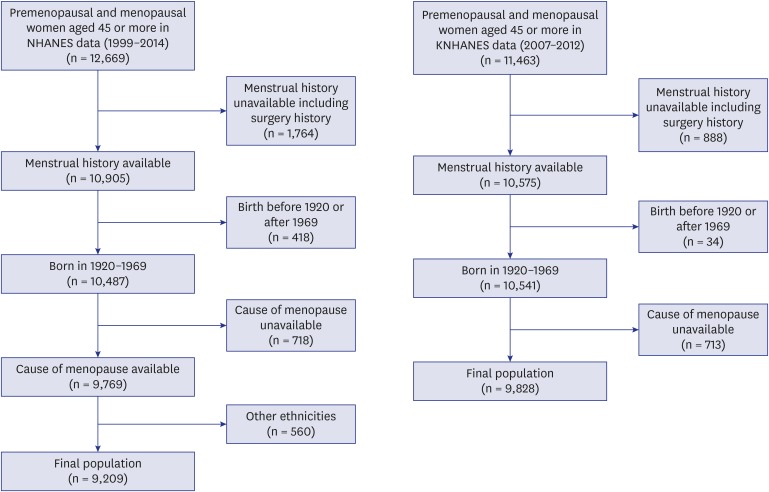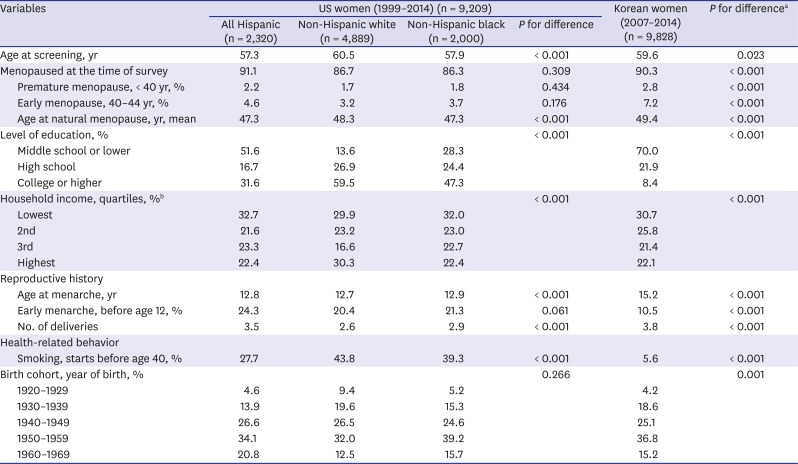1. McKinlay SM. The normal menopause transition: an overview. Maturitas. 1996; 23(2):137–145. PMID:
8735352.

2. Reynolds RF, Obermeyer CM. Age at natural menopause in Spain and the United States: results from the DAMES project. Am J Hum Biol. 2005; 17(3):331–340. PMID:
15849704.

3. Luborsky JL, Meyer P, Sowers MF, Gold EB, Santoro N. Premature menopause in a multi-ethnic population study of the menopause transition. Hum Reprod. 2003; 18(1):199–206. PMID:
12525467.

4. Haller-Kikkatalo K, Uibo R, Kurg A, Salumets A. The prevalence and phenotypic characteristics of spontaneous premature ovarian failure: a general population registry-based study. Hum Reprod. 2015; 30(5):1229–1238. PMID:
25712230.

5. Mishra GD, Pandeya N, Dobson AJ, Chung HF, Anderson D, Kuh D, et al. Early menarche, nulliparity and the risk for premature and early natural menopause. Hum Reprod. 2017; 32(3):679–686. PMID:
28119483.

6. Wu X, Cai H, Kallianpur A, Li H, Yang G, Gao J, et al. Impact of premature ovarian failure on mortality and morbidity among Chinese women. PLoS One. 2014; 9(3):e89597. PMID:
24603759.

7. Podfigurna-Stopa A, Czyzyk A, Grymowicz M, Smolarczyk R, Katulski K, Czajkowski K, et al. Premature ovarian insufficiency: the context of long-term effects. J Endocrinol Invest. 2016; 39(9):983–990. PMID:
27091671.

8. Muka T, Oliver-Williams C, Kunutsor S, Laven JS, Fauser BC, Chowdhury R, et al. Association of age at onset of menopause and time since onset of menopause with cardiovascular outcomes, intermediate vascular traits, and all-cause mortality: a systematic review and meta-analysis. JAMA Cardiol. 2016; 1(7):767–776. PMID:
27627190.
9. Kim YE, Park H, Jo MW, Oh IH, Go DS, Jung J, et al. Trends and patterns of burden of disease and injuries in Korea using disability-adjusted life years. J Korean Med Sci. 2019; 34(Suppl 1):e75. PMID:
30923488.

10. Faubion SS, Kuhle CL, Shuster LT, Rocca WA. Long-term health consequences of premature or early menopause and considerations for management. Climacteric. 2015; 18(4):483–491. PMID:
25845383.

11. Girard R, Météreau E, Thomas J, Pugeat M, Qu C, Dreher JC. Hormone therapy at early post-menopause increases cognitive control-related prefrontal activity. Sci Rep. 2017; 7(1):44917. PMID:
28322310.

12. Tibiletti MG, Testa G, Vegetti W, Alagna F, Taborelli M, Dalprà L, et al. The idiopathic forms of premature menopause and early menopause show the same genetic pattern. Hum Reprod. 1999; 14(11):2731–2734. PMID:
10548611.

13. Hoyos LR, Thakur M. Fragile X premutation in women: recognizing the health challenges beyond primary ovarian insufficiency. J Assist Reprod Genet. 2017; 34(3):315–323. PMID:
27995424.

14. Beck-Peccoz P, Persani L. Premature ovarian failure. Orphanet J Rare Dis. 2006; 1(1):9. PMID:
16722528.

15. Persani L, Rossetti R, Cacciatore C. Genes involved in human premature ovarian failure. J Mol Endocrinol. 2010; 45(5):257–279. PMID:
20668067.

16. Hewlett M, Mahalingaiah S. Update on primary ovarian insufficiency. Curr Opin Endocrinol Diabetes Obes. 2015; 22(6):483–489. PMID:
26512773.

17. Zsakai A, Mascie-Taylor N, Bodzsar EB. Relationship between some indicators of reproductive history, body fatness and the menopausal transition in Hungarian women. J Physiol Anthropol. 2015; 34(1):35. PMID:
26494263.

18. Hardy R, Kuh D. Reproductive characteristics and the age at inception of the perimenopause in a British National Cohort. Am J Epidemiol. 1999; 149(7):612–620. PMID:
10192308.

19. Gold EB. The timing of the age at which natural menopause occurs. Obstet Gynecol Clin North Am. 2011; 38(3):425–440. PMID:
21961711.

20. Forman MR, Mangini LD, Thelus-Jean R, Hayward MD. Life-course origins of the ages at menarche and menopause. Adolesc Health Med Ther. 2013; 4:1–21. PMID:
24600293.

21. Chang SH, Kim CS, Lee KS, Kim H, Yim SV, Lim YJ, et al. Premenopausal factors influencing premature ovarian failure and early menopause. Maturitas. 2007; 58(1):19–30. PMID:
17531410.

22. Yasui T, Hayashi K, Mizunuma H, Kubota T, Aso T, Matsumura Y, et al. Factors associated with premature ovarian failure, early menopause and earlier onset of menopause in Japanese women. Maturitas. 2012; 72(3):249–255. PMID:
22572589.

23. Hardy R, Kuh D. Social and environmental conditions across the life course and age at menopause in a British birth cohort study. BJOG. 2005; 112(3):346–354. PMID:
15713152.

24. Luoto R, Kaprio J, Uutela A. Age at natural menopause and sociodemographic status in Finland. Am J Epidemiol. 1994; 139(1):64–76. PMID:
8296776.

25. Lawlor DA, Ebrahim S, Smith GD. The association of socio-economic position across the life course and age at menopause: the British Women's Heart and Health Study. BJOG. 2003; 110(12):1078–1087. PMID:
14664879.

26. Kriplani A, Banerjee K. An overview of age of onset of menopause in northern India. Maturitas. 2005; 52(3-4):199–204. PMID:
16257611.

27. Kaczmarek M. The timing of natural menopause in Poland and associated factors. Maturitas. 2007; 57(2):139–153. PMID:
17307314.

28. Nichols HB, Trentham-Dietz A, Hampton JM, Titus-Ernstoff L, Egan KM, Willett WC, et al. From menarche to menopause: trends among US Women born from 1912 to 1969. Am J Epidemiol. 2006; 164(10):1003–1011. PMID:
16928728.

29. Pakarinen M, Raitanen J, Kaaja R, Luoto R. Secular trend in the menopausal age in Finland 1997–2007 and correlation with socioeconomic, reproductive and lifestyle factors. Maturitas. 2010; 66(4):417–422. PMID:
20537824.

30. Wang D, Wang M, Cheng N, Zheng T, Hu X, Li H, et al. Sulfur dioxide exposure and other factors affecting age at natural menopause in the Jinchuan cohort. Climacteric. 2015; 18(5):722–732. PMID:
25853925.

31. Mirel LB, Mohadjer LK, Dohrmann SM, Clark J, Burt VL, Johnson CL, et al. National health and nutrition examination survey: estimation procedures, 2007–2010. Vital Health Stat 2. 2013; (159):1–17.
32. Curtin LR, Mohadjer LK, Dohrmann SM, Kruszon-Moran D, Mirel LB, Carroll MD, et al. National health and nutrition examination survey: sample design, 2007–2010. Vital Health Stat 2. 2013; (160):1–23.
33. Park HA. The Korea national health and nutrition examination survey as a primary data source. Korean J Fam Med. 2013; 34(2):79. PMID:
23560205.

34. Wise LA, Krieger N, Zierler S, Harlow BL. Lifetime socioeconomic position in relation to onset of perimenopause. J Epidemiol Community Health. 2002; 56(11):851–860. PMID:
12388578.

35. Tawfik H, Kline J, Jacobson J, Tehranifar P, Protacio A, Flom JD, et al. Life course exposure to smoke and early menopause and menopausal transition. Menopause. 2015; 22(10):1076–1083. PMID:
25803667.

36. Park YJ, Kim HS, Kang HC. The age at menopause and related factors in Korean women. J Korean Acad Nurs. 2002; 32(7):1024–1031.

37. Shin YJ, Song JY, Kim MJ, Choi JI, Han KD, Lee HN. Relationship between age at last delivery and age at menopause: the Korea national health and nutrition examination survey. Obstet Gynecol Sci. 2017; 60(4):362–368. PMID:
28791268.

38. Committee Opinion No. 605: primary ovarian insufficiency in adolescents and young women. Obstet Gynecol. 2014; 123:193–197.
39. Agaba P, Meloni S, Sule H, Ocheke A, Agaba E, Idoko J, et al. Factors associated with early menopause among women in Nigeria. J Virus Erad. 2017; 3(3):145–151. PMID:
28758022.

40. Deering VA. Prevalence of premature ovarian failure and premature menopause in refugee and immigrant women in the U.S. compared to that of women born in the United States [Thesis]. New York, NY: Stony Brook University;2014.
41. Elias SG, van Noord PA, Peeters PH, den Tonkelaar I, Grobbee DE. Caloric restriction reduces age at menopause: the effect of the 1944-1945 Dutch famine. Menopause. 2003; 10(5):399–405. PMID:
14501600.

42. Wang N, Huang Y, Wen J, Su Q, Huang Y, Cai L, et al. Early life exposure to famine and reproductive aging among Chinese women. Menopause. 2019; 26(5):463–468. PMID:
30516712.

43. Yarde F, Broekmans FJ, van der Pal-de Bruin KM, Schönbeck Y, te Velde ER, Stein AD, et al. Prenatal famine, birthweight, reproductive performance and age at menopause: the Dutch hunger winter families study. Hum Reprod. 2013; 28(12):3328–3336. PMID:
23966246.

44. Hardy R, Kuh D. Does early growth influence timing of the menopause? Evidence from a British birth cohort. Hum Reprod. 2002; 17(9):2474–2479. PMID:
12202444.

45. Wang M, Yi Y, Roebothan B, Colbourne J, Maddalena V, Wang PP, et al. Body mass index trajectories among middle-aged and elderly Canadians and associated health outcomes. J Environ Public Health. 2016; 2016:7014857. PMID:
26925112.

46. de Vries E, den Tonkelaar I, van Noord PA, van der Schouw YT, te Velde ER, Peeters PH. Oral contraceptive use in relation to age at menopause in the DOM cohort. Hum Reprod. 2001; 16(8):1657–1662. PMID:
11473959.
47. van Noord PA, Dubas JS, Dorland M, Boersma H, te Velde E. Age at natural menopause in a population-based screening cohort: the role of menarche, fecundity, and lifestyle factors. Fertil Steril. 1997; 68(1):95–102. PMID:
9207591.

49. Pokoradi AJ, Iversen L, Hannaford PC. Factors associated with age of onset and type of menopause in a cohort of UK women. Am J Obstet Gynecol. 2011; 205(1):34.e1–34.13. PMID:
21514918.

50. Ferreira JM, Monteiro I, Castro S, Villarroel M, Silveira C, Bahamondes L. The use of long acting reversible contraceptives and the relationship between discontinuation rates due to menopause and to female and male sterilizations. Rev Bras Ginecol Obstet. 2016; 38(5):210–217. PMID:
27187927.

51. Kavanaugh ML, Jerman J. Contraceptive method use in the United States: trends and characteristics between 2008, 2012 and 2014. Contraception. 2018; 97(1):14–21. PMID:
29038071.

52. Ha K, Kim K, Chun OK, Joung H, Song Y. Differential association of dietary carbohydrate intake with metabolic syndrome in the US and Korean adults: data from the 2007-2012 NHANES and KNHANES. Eur J Clin Nutr. 2018; 72(6):848–860. PMID:
29339830.









 PDF
PDF Citation
Citation Print
Print




 XML Download
XML Download